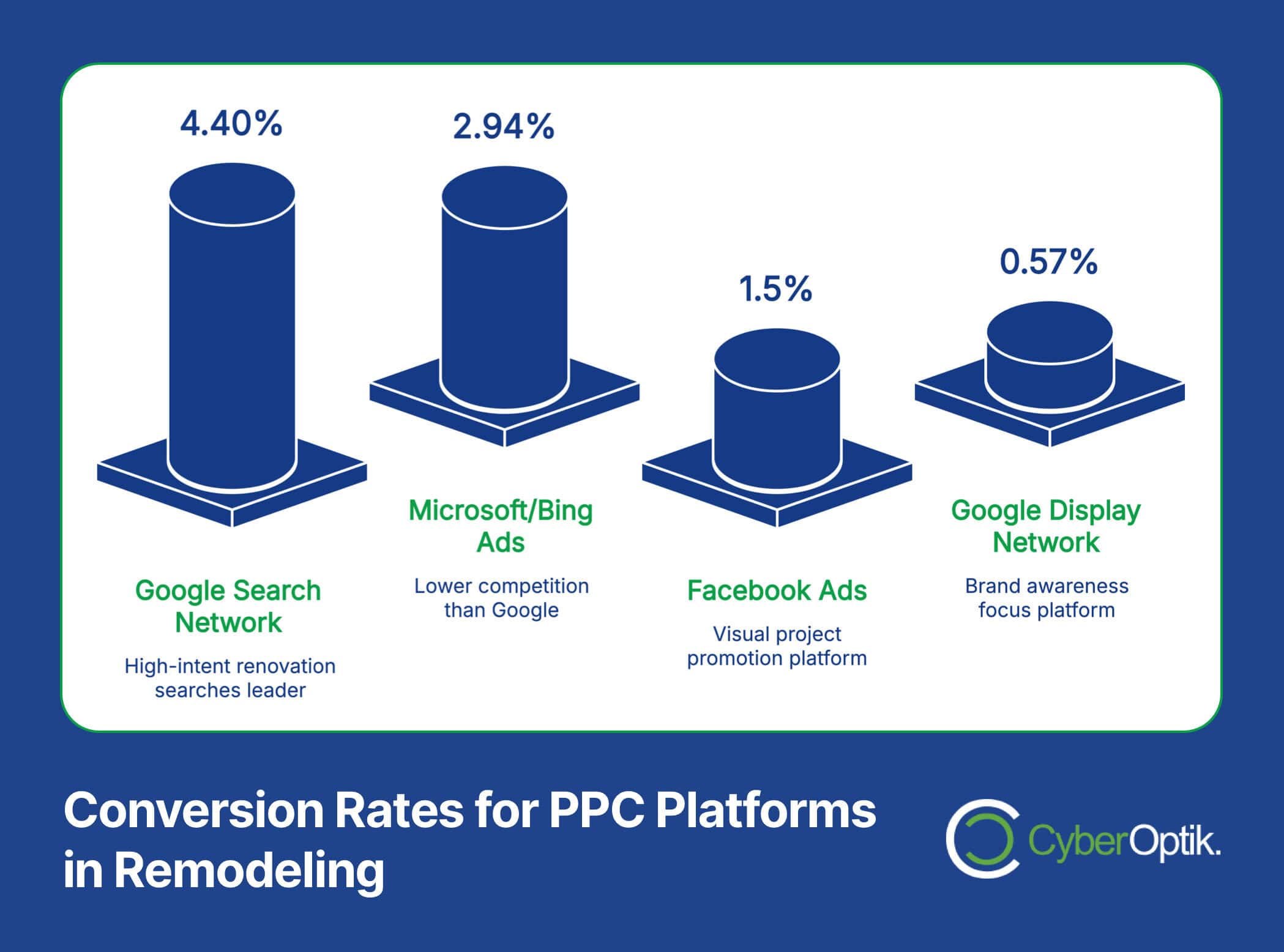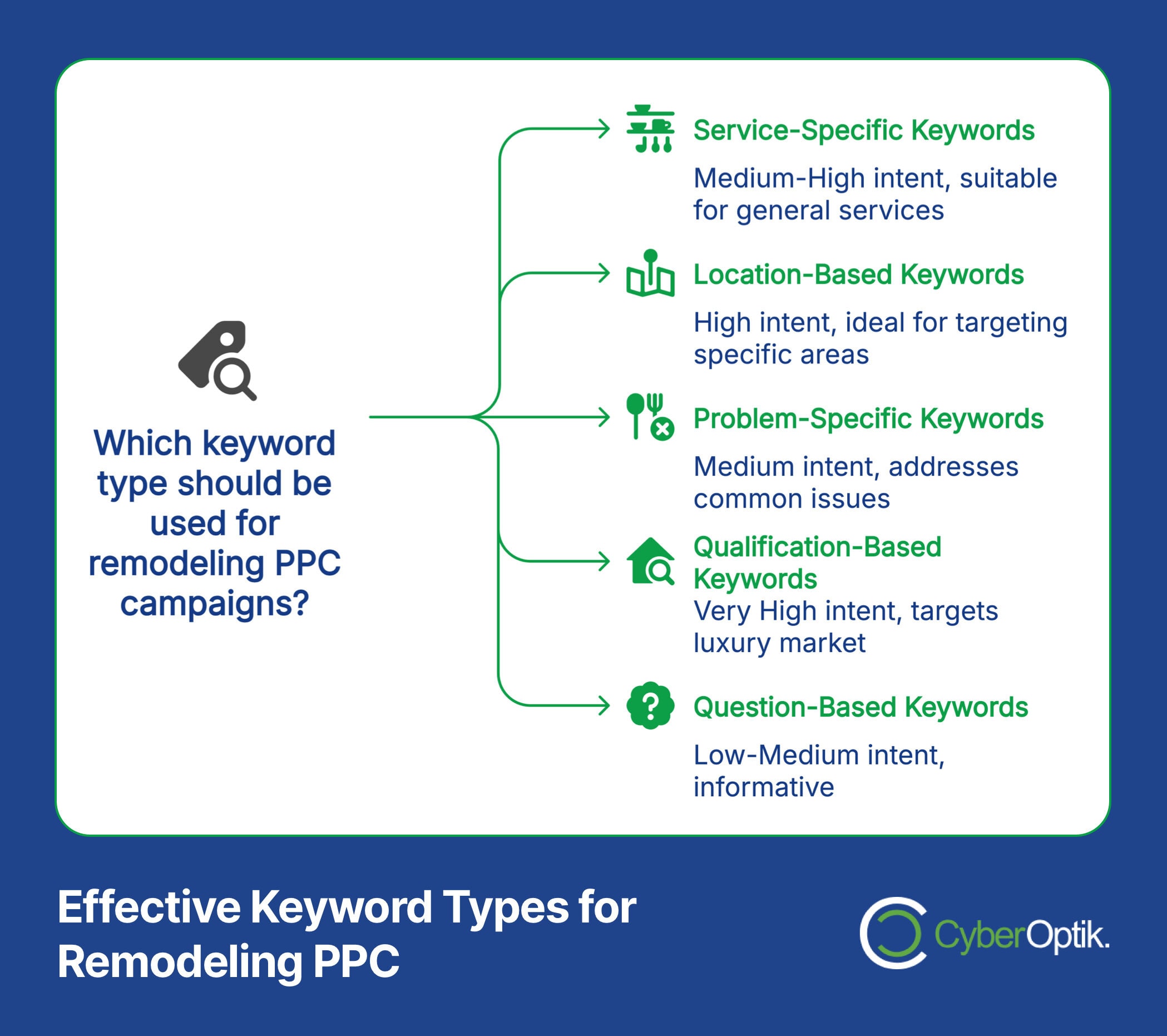In today’s competitive home improvement landscape, remodeling businesses need effective digital marketing strategies to stand out. Pay-per-click advertising offers an immediate way to connect with potential clients actively searching for your services. But how can you ensure your remodeling PPC campaigns deliver the conversions and ROI your business needs?
We understand the unique challenges remodeling companies face in the digital space. Creating campaigns that actually convert requires more than simply bidding on keywords and hoping for the best. It demands a strategic approach built on industry benchmarks, targeted optimization, and ongoing refinement.
For many remodeling business owners, understanding what is PPC in marketing and how does it work for your business? can seem overwhelming. But with the right guidance, you can transform your advertising spend from a cost center into a revenue-generating machine.
In this guide, we’ll break down the proven strategies that drive real results for remodeling companies. Let’s explore how to craft campaigns that attract quality leads while maximizing every dollar of your marketing budget.
Understanding PPC in the Remodeling Industry

PPC advertising works quickly. It places your remodeling business at the top of search results when potential clients actively search for renovation services. This visibility creates immediate opportunities that organic methods cannot match. Timing matters in home improvement.
The remodeling industry has unique characteristics that affect PPC performance. Homeowners making significant renovation investments typically conduct extensive research before contacting companies. This extended decision process impacts how campaigns should be structured.
Why does PPC matter specifically for remodeling businesses? The answer lies in intent. When someone searches for “kitchen remodeling contractor near me,” they demonstrate high purchase intent. PPC lets you capture these valuable prospects at the perfect moment.
Data shows that PPC converts 50% better than organic traffic for high-intent searches. (Source: Cropink) This advantage becomes particularly important in competitive markets where remodeling companies vie for attention.
Before creating campaigns, consider comparing SEO and PPC performance for long-term growth. While organic strategies build sustainable traffic, PPC delivers immediate visibility. Most successful remodeling companies utilize both approaches in their marketing mix.
PPC Conversion Benchmarks for Remodeling Businesses
Understanding industry standards helps set realistic expectations for your campaigns. While remodeling-specific data is limited, we can examine related industries to establish reliable benchmarks. Let’s explore the numbers that matter.
When evaluating PPC performance, conversion rate serves as the primary metric. Across all industries, the average PPC conversion rate stands at 2.55%. (Source: PPC.io) However, home service businesses often perform better than this baseline.
The platform you choose significantly impacts results. Google Search Network delivers an average conversion rate of 4.40%, while Google Display Network comes in much lower at 0.57%. (Source: SEO.com) This substantial difference highlights the importance of platform selection.
The following table provides a comprehensive breakdown of conversion benchmarks by platform to help guide your expectations:
| Platform | Average Conversion Rate | Notes for Remodeling Companies |
|---|---|---|
| Google Search Network | 4.40% | Best for capturing high-intent renovation searches |
| Google Display Network | 0.57% | Better for brand awareness than direct conversions |
| Microsoft/Bing Ads | 2.94% | Often lower competition than Google |
| Facebook Ads | Varies (~1-2%) | Excellent for showcasing visual renovation projects |
These benchmarks provide a starting point for evaluation. Your specific results may vary based on factors like geographic location, service specialization, and campaign quality.
Looking at related industries provides additional context. Legal services achieve the highest conversion rates at 7.90%, while home services typically fall in the 3-5% range. (Source: WordStream) Your remodeling business should aim for these higher benchmarks with proper optimization.
Key Factors Affecting Remodeling PPC Performance
Multiple elements influence how well your remodeling PPC campaigns perform. Understanding these factors helps create strategies that maximize results. Let’s examine what truly moves the needle.
Audience targeting stands as perhaps the most critical component. Remodeling services target homeowners with specific characteristics. Refining your audience by location, income level, home value, and renovation interests dramatically improves performance.
Keyword selection directly impacts both cost and conversion potential. The remodeling industry features terms with widely varying costs and intent. Strategic keyword research identifies opportunities where competition and cost align with conversion potential.
Landing page relevance often makes or breaks campaigns. When a prospect clicks your ad, the destination page must immediately confirm they’re in the right place. Tailored landing pages for specific services (kitchens, bathrooms, additions) outperform general pages.
The following table highlights the relative impact of various factors on your campaign performance:
| Performance Factor | Impact Level | Optimization Priority |
|---|---|---|
| Keyword Selection | Very High | 1 - Critical |
| Landing Page Quality | Very High | 1 - Critical |
| Ad Copy Relevance | High | 2 - Important |
| Bid Management | Medium-High | 2 - Important |
| Geographic Targeting | High | 1 - Critical |
| Device Optimization | Medium | 3 - Secondary |
Budget management requires careful consideration in remodeling PPC. Unlike lower-cost services, remodeling projects represent significant investments. This reality affects both customer decision timelines and campaign structure requirements.
Industry-specific statistics reveal that home improvement keywords often carry higher costs per click. While legal services top the chart at $6.98 per click, home service terms typically range from $4-6 per click. (Source: WordStream) This cost structure demands careful optimization to maintain profitability.
Optimizing Your Remodeling PPC Ad Campaigns
Creating high-performing campaigns requires attention to multiple elements. Let’s break down the optimization process into actionable components that drive results for remodeling businesses.
Strategic Keyword Selection

Keyword research comes first. It forms the foundation of every successful remodeling PPC campaign. Focus on terms that indicate serious renovation intent rather than casual browsing. The quality of this research directly impacts campaign performance.
High-intent keywords generate better leads. Terms like “kitchen remodeling contractor” or “bathroom renovation company near me” signal strong purchase intent. These phrases typically convert better than general terms like “remodeling ideas” despite often carrying higher costs.
Negative keywords protect your budget. They prevent your ads from showing for irrelevant searches. For remodeling businesses, terms like “DIY,” “how to,” and “cost estimates” often indicate information-seeking rather than hiring intent. Excluding these terms improves campaign efficiency.
Geographic modifiers enhance relevance. Since remodeling is inherently local, including location terms in your keyword strategy improves targeting precision. This approach delivers better-qualified leads while often reducing cost per click through increased quality scores.
The table below illustrates effective keyword types for remodeling PPC campaigns:
| Keyword Type | Example | Intent Level | Expected CPC |
|---|---|---|---|
| Service-Specific | "kitchen remodeling services" | Medium-High | Medium-High |
| Location-Based | "bathroom remodeler Chicago" | High | High |
| Problem-Specific | "outdated kitchen renovation" | Medium | Medium |
| Qualification-Based | "luxury home remodeling company" | Very High | Very High |
| Question-Based | "how much does kitchen remodel cost" | Low-Medium | Low-Medium |
Crafting High-Converting Ad Copy
Ad copy drives clicks. Effective remodeling ads address specific customer pain points and desires. Homeowners want beauty, functionality, value, and reliability. Your copy should speak directly to these motivations.
Headlines matter most. They capture attention in crowded search results. Including your primary keyword, a compelling benefit, and a sense of urgency creates high-performing headlines. Testing multiple variations reveals what resonates with your audience.
Social proof builds trust quickly. Incorporating elements like “award-winning,” “5-star rated,” or “15+ years of experience” addresses the inherent risk homeowners feel when selecting a remodeling contractor. These trust signals improve click-through and conversion rates.
Calls-to-action drive next steps. Clear direction like “Get Your Free Consultation” or “See Your New Kitchen in 3D” creates specific pathways to engagement. These CTAs outperform generic phrases like “Learn More” or “Contact Us” in driving qualified leads.
The following table highlights essential components of high-performing remodeling PPC ads:
| Ad Component | Purpose | Example for Remodeling |
|---|---|---|
| Primary Headline | Capture attention with key benefit | Transform Your Kitchen in Just 3 Weeks |
| Secondary Headline | Address pain point or add detail | Custom Designs That Stay Within Your Budget |
| Description | Expand on benefits and credibility | Award-winning designers create stunning spaces with quality craftsmanship. 100+ 5-star reviews. |
| Call-to-Action | Direct clear next step | Get Your Free Design Consultation Today |
| Extensions | Provide additional information | Callouts: "Financing Available" | "Licensed & Insured" | "3D Design Preview" |
Landing Page Optimization for Remodeling Leads
Landing pages convert clicks into leads. For remodeling companies, these pages must immediately establish trust while making the next step obvious. The disconnect between ads and landing pages represents one of the most common conversion killers.
Visual evidence matters tremendously. High-quality before/after photos of your actual work provides powerful proof of capability. These images should appear above the fold where visitors see them immediately upon arrival.
The landing page experience directly impacts quality score and cost per click. Pages that deliver what the ad promised receive better scores from Google, resulting in lower costs and better ad positions. This alignment becomes particularly important in competitive remodeling markets.
Form simplicity increases completion rates. Long forms create friction that reduces conversions. For initial remodeling inquiries, limit fields to name, email, phone, project type, and timeframe. This approach balances lead quality with conversion rate optimization.
The median conversion rate for landing pages across industries stands at 6.6%. (Source: Unbounce) Well-designed remodeling landing pages should target this benchmark as a minimum performance standard.
Advanced PPC Strategies for Remodeling Companies
Once you’ve established baseline campaigns, advanced strategies can further improve performance. These approaches build upon fundamental best practices to create sophisticated marketing systems that deliver superior results.
Remarketing Campaigns
Remarketing delivers exceptional value. The remodeling sales cycle often extends over weeks or months as homeowners research options. Implementing remarketing strategies to reconnect with potential customers keeps your company visible throughout this extended decision process.
Different remarketing audiences require tailored messaging. Someone who viewed kitchen remodeling services needs different content than someone who examined bathroom renovations. This segmentation improves relevance and conversion rates.
Frequency caps prevent ad fatigue. While staying visible matters, excessive exposure can create negative impressions. Limiting impressions to 3-4 per day strikes an effective balance between awareness and annoyance for remodeling prospects.
Value progression enhances remarketing effectiveness. Initial remarketing ads might showcase project galleries, while later exposures could present testimonials or special offers. This sequential approach moves prospects through the decision journey more effectively than static messaging.
Local Service Ads Implementation
Google’s Local Service Ads offer unique benefits for remodelers. These ads appear above traditional paid search results with a Google Guaranteed badge, generating high trust and click-through rates. This placement provides a competitive advantage in crowded markets.
Qualification requirements include background checks, license verification, and insurance validation. While this process requires effort, it creates a barrier to entry that reduces competition. This screening benefits established, professional remodeling companies.
The pay-per-lead model changes the economics of advertising. Rather than paying for clicks that may not convert, you pay only when someone contacts your business directly. This approach often delivers better ROI for remodeling companies with strong close rates.
Reviews directly impact Local Service Ad placement. Google prioritizes companies with higher quantities of positive reviews. Implementing a systematic review generation process becomes particularly valuable for this ad format.
Measuring and Improving PPC ROI for Remodelers
ROI measurement matters most. Unlike other industries with smaller transaction values, remodeling companies must carefully track costs against project revenue. A single conversion can represent thousands in profit, making accurate attribution essential.
The fundamental PPC ROI formula works like this: (Revenue from PPC Leads – Cost of PPC) / Cost of PPC = ROI. For example, if you spend $2,000 on PPC, generating $20,000 in project revenue, your ROI is 900% ($18,000/$2,000).
Proper conversion tracking enables accurate measurement. Many remodeling companies track lead submissions but fail to connect these leads to actual projects and revenue. Implementing tracking from click through project completion allows for true performance evaluation.
Consider lifetime value in ROI calculations. Remodeling clients often become repeat customers or referral sources. A kitchen remodeling client who later returns for bathroom renovations and refers two neighbors represents significantly more value than the initial project alone.
Industry data shows that Google Ads delivers an average of $8 in revenue for every $1.60 spent. (Source: WebFX) With proper optimization, remodeling companies can achieve even better returns due to high project values.
Common Remodeling PPC Mistakes to Avoid
Many remodeling companies make costly errors in their PPC approach. Understanding these common pitfalls helps prevent wasted budget and missed opportunities. Let’s examine the most frequent mistakes.
Geographic targeting errors waste significant budget. Serving ads to prospects outside your service area generates clicks that can never convert. Define precise geographic boundaries based on your willingness to travel for projects.
Failing to separate search and display campaigns creates performance issues. These networks function differently and require distinct strategies. Search captures active intent while display builds awareness. Combining them obscures performance data and prevents proper optimization.
Weak qualification in ad copy leads to poor-quality leads. Remodeling companies seeking high-value projects benefit from qualifying language like “luxury,” “custom,” or “starting at $X.” This pre-qualification improves lead quality even while potentially reducing lead volume.
Ignoring call tracking represents a critical mistake. Many remodeling leads prefer calling rather than submitting forms. Without call tracking, companies miss attribution for a significant portion of their PPC-generated business, leading to undervaluation of campaign performance.
Generic landing pages substantially reduce conversion rates. Using your website’s homepage or general service pages for PPC traffic creates disconnects between ad promises and user experience. Each major service category deserves a dedicated landing page optimized for conversion.
Building a Sustainable PPC Strategy for Your Remodeling Business
PPC success requires consistent effort. The most effective remodeling companies treat paid advertising as an ongoing system rather than a one-time campaign. This approach enables continuous improvement through testing and refinement.
Building a complete digital ecosystem maximizes PPC effectiveness. Your paid advertising should integrate seamlessly with your website, CRM, email marketing, and sales process. This integration creates a cohesive customer journey from first click to project completion.
Regular performance analysis drives continuous improvement. Set a monthly review cadence to evaluate key metrics, identify opportunities, and implement refinements. This disciplined approach prevents campaigns from stagnating or declining over time.
The remodeling industry presents unique PPC opportunities for companies that execute strategically. By implementing the best practices outlined in this guide, you can create campaigns that consistently generate high-quality leads while delivering exceptional return on investment.
Ready to Improve Your Remodeling PPC Results?
If you’re looking to enhance your remodeling company’s online lead generation, our team specializes in specialized PPC approaches for home services businesses. We understand the unique challenges of marketing remodeling services and can help you build campaigns that deliver measurable results.




